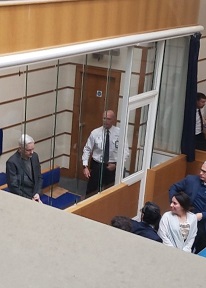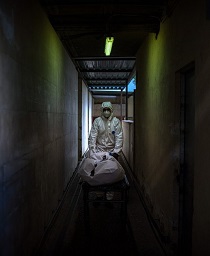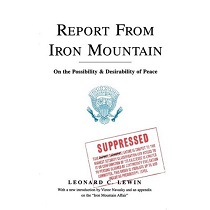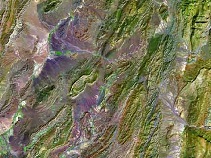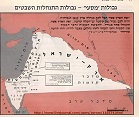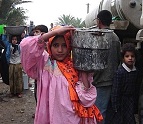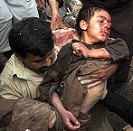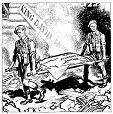Gaza's Poisoned Water
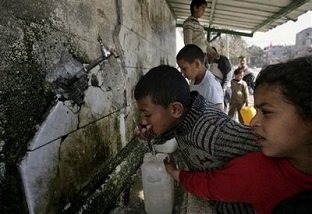
[PHOTO: A Palestinian boy drinks from a water tap as others wait to fill up water containers in Khan Younis in the southern Gaza Strip, Wednesday, Feb. 27, 2008. The Gaza Strip's water provider on Wednesday urged the area's 1.5 million people to boil their drinking water, citing a dire shortage of chlorine as a result of an Israeli economic blockade. The chlorine shortage is another addition to Gaza's water woes. Most residents don't have regular water supplies because of a shortage of diesel, used to pump water. (AP Photo/ Eyad Baba)]
This article follows an August 6 one discussing Palestinians Denied Access to Water, found through THIS link.
It explained how Israel exploits Palestinian water resources, using most of it, forcing them to find ways to get by. Water, of course, is essential to life, rights to it natural and usufructuary. Belonging to everyone as part of the commons, it must be used, not owned or abused, an essential truth Israel corrupts.
On August 5, the Palestinian Centre for Human Rights (PCHR) published the latest in its "Narratives Under Siege" series, titled "There's Something in the Water: The Poisoning of Life in the Gaza Strip."
"THIS BEACH IS POLLUTED" signs dot Gaza City beaches, posing serious health hazards because of daily raw sewage dumped into the Mediterranean Sea through 16 discharge sites along the coast. Yet thousands fill them despite the dangers, including children, taking advantage of one of their few sources of respite - available, convenient, and free, but not safe.
For Gazans, the sea is part of their lives - to fish, gather with family, swim, and for children, play in the sun on hot days, a joy this writer recalls growing up on America's Atlantic coast. Summers were always the best time. The memories remain.
"Without the sea there is no Gaza," explains Abdel Haleem Abu Samra, Public Relations Officer of the Palestinian Centre for Human Rights' Khan Younis Branch. Being unsafe is especially unsettling - its state in some form since 1991, but especially under siege, prohibiting equipment, construction materials, and spare parts to build new wastewater treatment facilities and repair existing ones.
In addition, conditions are exacerbated by an acute fuel and electricity shortage, vital to run waste treatment cycles properly. As a result, about 20,000 cubic meters of raw sewage are dumped daily into the sea, according to Monther Shoblak, Director General of the Coastal Municipality Water Utility, and in some areas it's up to four times that much - a shocking, completely avoidable situation.
Gaza's once pristine shores are polluted, the grave implications clear - "the Gaza Strip is, quite literally, being poisoned," affecting about 90% of its coastal aquifer, the essential source for residents. Yet it's hazardous and undrinkable, given its high nitrate and chloride levels - six to seven times higher than World Health Organization's (WHO) safe levels.
As director of Gaza's water, Monther's job is challenging, forcing him to improvise to make due, managing wastewater created by 1.5 million trapped people, 80% of them in refugee camps, living cramped in the world's largest open-air prison, out of sight and mind to those outside it, except activists, friends, and supporters who care. Plagued also by inadequate infrastructure, creating hazards unimaginable in the West.
Monther compares Gaza's facilities to an old car still in use despite lack of spare parts needed for upkeep. Eventually falling into disrepair, it pollutes heavily, relevant for Gaza where even adulterated gasoline is the normal input for cars.
Compounding things further, Gaza's population is growing rapidly (about 3.6% annually), producing greater amounts of waste, current facilities only able to handle about 32,000 cubic meters a day, about half its needed capacity. As a result, the overage gets dumped, entirely or mostly untreated, much of it washing back onshore, polluting beaches, creating hazardous swimming conditions, and poisoning drinking water.
In northern Gaza's Beit Lahia, deterioration is especially severe, one of its three facilities receiving over 25,000 cubic meters daily, double its operating capacity. Worse still, the facility has no access to the sea, so wastewater flows directly into the surrounding area, creating a 450 dunum sewage lake, untenable contamination, exacerbated in March 2007 when its embankment broke, killing five people by toxic flooding.
High nitrate levels are especially hazardous, Monther calling them "a silent killer"- colorless, odorless and tasteless, its continued intake reducing oxygen to vital tissues like the brain. Children and infants are greatly at risk, their developing organs unable to cope. Severe damage and at times death the result.
The longer-term consequences are worrisome, Sara Roy saying:
"Nowhere else in the world has such a large number of people been exposed to such high levels of nitrates for such a long period of time. There is no precedent, and no studies to help us understand what happens to people over the course of years of nitrate poisoning."
The harm is undeniable because the coastal aquifer along much of the Strip provides about 90% of its water. For Gazans like everyone, it's life, nature's gift, and essential. There's no substitute, making it vital to conserve and keep safe, for drinking and Gaza's agriculture, especially its citrus farms, deservedly famous, now threatened by toxic and dangerous pollution.
Only 10% of Gaza's aquifer is safe, and without changes, Monther fears it'll all be poisoned, making it hazardous for any purpose. A 2009 United Nations Environment Program (UNEP) report warned that today's damage "could take centuries to reverse." Under siege, Gazans have no choice but to cope, pitting them against nature, never a fair fight when it's hostile.
A Final Comment
A July 22 Electronic Intifada report headlined "Gaza's strawberries spoil under siege," explaining:
"The northern Gaza Strip area of Beit Lahiya is famous for its agriculture," an ideal environment for growing fruit under normal conditions, absent under siege. Besides polluted water, farmers like Abdulfattah al-Khateeb worry about his strawberries reaching West Bank, Israeli and European markets, their destination for over 20 years.
Since 2007, however, closure cut him off from the rest of the world, leaving "tons of his strawberries....rot(ting) while waiting in vain at the Israeli border." As a result, he fears his livelihood is being lost.
Before 1967, Gaza's citrus was called "yellow gold," renown for its quality. Under Israeli control, many orange groves were bulldozed, farmers turning instead to flowers and strawberries. They adapted, producing "the best strawberries in the world," according to Abdulfattah, former head of Beit Lahiya's Strawberry Farmers Society.
Now he and others are forced to abandon their crops because of export restrictions. "The effects have been disastrous," farmers reporting a 40% drop in income, losing millions of dollars.
"The Israelis tell us how and what to plant, what to use to plant it, and where the plants we use must come from, (and) when we do what (they) want, they just create another problem," he explains. Half of Gaza's strawberry farmers have given up. The others are threatened, especially by Cast Lead's destruction of nearly half of Gaza's farmland. Relentlessly, Israel is destroying a way of life in Gaza, a little reported story vital to highlight and contest.
___________________________________________________________________________________

Stephen Lendman: I was born in 1934 in Boston, MA. Raised in a modest middle class family, attended public schools, received a BA from Harvard University in 1956 and an MBA from the Wharton School at the University of PA in 1960 following 2 years of obligatory military service in the US Army. Spent the next 6 years as a marketing research analyst for several large US corporations before becoming part of a new small family business in 1967, remaining there until retiring at the end of 1999. Have since devoted my time and efforts to the progressive causes and organizations I support, all involved in working for a more humane and just world for all people everywhere, but especially for the most needy, disadvantaged and oppressed. My efforts since summer 2005 have included writing on a broad range of vital topics ranging from war and peace; social, economic and political equity for all; and justice for all the oppressed peoples of the world like the long-suffering people of Haiti and the Palestinians. Also co-hosting The Global Research News Hour, occasional public talks, and frequent appearances on radio and at times television.
Stephen Lendman is a Research Associate of the Centre for Research on Globalization. He lives in Chicago and can be reached at lendmanstephen@sbcglobal.net. Also visit his blog site sjlendman.blogspot.com and listen to The Lendman News Hour on RepublicBroadcasting.org Monday - Friday at 10AM US Central time for cutting-edge discussions with distinguished guests on world and national issues. All programs are archived for easy listening.
___________________________________________________________________________________
URL: http://www.a-w-i-p.com/index.php/2010/08/14/gaza-s-poisoned-water

